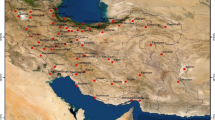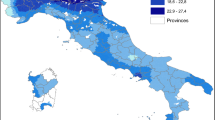Abstract
In this paper, we examine the impact of air pollution on the job location choice of a highly educated labor force. Using the administrative job contract records of all graduates from Tsinghua University from 2005 to 2016, we find that air pollution significantly reduces the probability of elite graduates accepting job offers in a polluted city. Specifically, all else equal, if a city’s PM2.5 level increases by 10 μg/m3, the share of Tsinghua graduates choosing that city will decrease by 0.23 percentage point (9% of the mean value). This “crowding-out” effect is larger for master’s and doctoral graduates, but insignificant for undergraduates. A placebo test finds this effect does not exist for individuals who had signed a job contract prior to university admission, which strengthens our finding. Heterogeneity analysis indicates that males, students who grew up in cleaner provinces, and students graduating from school of the environment are more sensitive to air pollution. Different levels of preference for clean air and tolerance to pollution, as well as whether having the knowledge of pollution’s harms, can effectively explain the heterogeneous effect of air pollution’s impacts on job location choices of those elites.

Similar content being viewed by others
Notes
See reports in China Business Review (https://www.chinabusinessreview.com/air-pollution-impedes-executive-hiring-in-china/), Reuters (https://www.reuters.com/article/us-china-pollution-survey-idUSBREA2I0KU20140319) and Bloomberg (https://www.bloomberg.com/news/articles/2014-04-10/chinas-pollution-costs-companies-in-air-filters-employee-perks).
There are 35 large and medium-sized cities in China, including Beijing, Tianjin, Shijiazhuang, Taiyuan, Huhehaote, Shenyang, Dalian, Changchun, Harbin, Shanghai, Nanjing, Hangzhou, Ningbo, Hefei, Fuzhou, Xiamen, Nanchang, Jinan, Qingdao, Zhengzhou, Wuhan, Changsha, Guangzhou, Shenzhen, Nanning, Haikou, Chongqing, Chengdu, Guiyang, Kunming, Xi'an, Lanzhou, Xining, Yinchuan, Urumqi. During our study period, more than 94% of Tsinghua graduates chose to work in one of the large and medium-sized cities in China, which means elite graduates seldom select to work in small cities, and thus we set the large and medium-sized cities as their potential working places.
We also use the ranks of PM2.5 as well as other economic variables of Beijing among the 35 large and medium-sized cities in the graduates’ location choice model, the results are consistent with those using the relative level indicators.
We also try to cluster the standard errors by students’ department (also major) as a robustness check. The results are consistent with the results when clustering the standard errors at the home province level.
The choice of cohort that is just 1 year earlier, sharejt−1, is not used because it is also highly influenced by the pmjt−1. For samples in 2005/2006, we use the average share in the whole study period as the 2-year-lag choice share.
As for the choice of cutoffs (60 km and 300 km), we refer to the study of Fan et al. (2018). We also tried different distances and the results are robust.
We calculate the variance inflation factors (VIFs) for independent variables, which are all less than 3, thus indicating there is little risk of multicollinearity in this model.
Stock et al. (2005) estimate the critical value of the Cragg–Donald statistic to be equal to 16.38 for a model with one endogenous regressors and one instrument.
If ding xiang pei yang students refuse to comply with the contract after graduation, they will be charged a high penalty, which is double the amount of the subsidy received during their whole study period. Further, they cannot receive their diploma from Tsinghua University and cannot register for graduation information online for 5 years.
References
Bartik TJ (1991) Who benefits from state and local economic development policies? Kalamazoo, MI: WE Upjohn Institute for Employment Research
Barwick PJ, Li S, Rao D, Zahur NB (2018) The morbidity cost of air pollution: evidence from consumer spending in China (no. w24688). National Bureau of Economic Research
Bayer P, Keohane N, Timmins C (2009) Migration and hedonic valuation: the case of air quality. J Environ Econ Manag 58(1):1–14
Bobak M (2000) Outdoor air pollution, low birth weight, and prematurity. Environ Health Perspect 108(2):173
Chang T, Graff Zivin J, Gross T, Neidell M (2016) Particulate pollution and the productivity of pear packers. Am Econ J Econ Policy 8(3):141–169
Chay KY, Greenstone M (2003) Air quality, infant mortality, and the Clean Air Act of 1970 (no. w10053). National Bureau of Economic Research
Chen Y, Ebenstein A, Greenstone M, Li H (2013) Evidence on the impact of sustained exposure to air pollution on life expectancy from China’s Huai River policy. Proc Natl Acad Sci 110(32):12936–12941
Currie J, Neidell M (2005) Air pollution and infant health: what can we learn from California’s recent experience? Q J Econ 120(3):1003–1030
Currie J, Hanushek EA, Kahn EM, Neidell M, Rivkin SG (2009) Does pollution increase school absences? Rev Econ Stat 91(4):682–694
Dockery DW, Pope CA, Xu X, Spengler JD, Ware JH, Fay ME, Ferris BG Jr, Speizer FE (1993) An association between air pollution and mortality in six US cities. N Engl J Med 329(24):1753–1759
Dominici F, Peng RD, Bell ML, Pham L, McDermott A, Zeger SL, Samet JM (2006) Fine particulate air pollution and hospital admission for cardiovascular and respiratory diseases. JAMA 295(10):1127–1134
Faggian A, McCann P, Sheppard S (2006) An analysis of ethnic differences in UK graduate migration behaviour. Ann Reg Sci 40(2):461–471
Fan H, Lai W, Song H, Wang H (2018) Air pollution and brain drain: evidence from job location choices of college graduates. Working paper
Ghanem D, Zhang J (2014) ‘Effortless perfection:’ Do Chinese cities manipulate air pollution data? J Environ Econ Manag 68(2):203–225
Graff Zivin J, Neidell M (2012) The impact of pollution on worker productivity. Am Econ Rev 102(7):3652–3673
Gupta P, Christopher SA, Wang J, Gehrig R, Lee YC, Kumar N (2006) Satellite remote sensing of particulate matter and air quality assessment over global cities. Atmos Environ 40(30):5880–5892
Hanna R, Oliva P (2015) The effect of pollution on labor supply: evidence from a natural experiment in Mexico City. J Public Econ 122:68–79
Kumar P, Morawska L, Martani C, Biskos G, Neophytou M, Di Sabatino S, Bell M, Norford L, Britter R (2015) The rise of low-cost sensing for managing air pollution in cities. Environ Int 75:199–205
Levinson A (2012) Valuing public goods using happiness data: the case of air quality. J Public Econ 96(9–10):869–880
Li Z, Folmer H, Xue J (2014) To what extent does air pollution affect happiness? The case of the Jinchuan mining area, China. Ecol Econ 99:88–99
Li T, Liu H, Salvo A (2015) Severe air pollution and labor productivity (no. 8916). IZA discussion papers
Luechinger S (2009) Valuing air quality using the life satisfaction approach. Econ J 119(536):482–515
Luechinger S (2010) Life satisfaction and transboundary air pollution. Econ Lett 107(1):4–6
MacKerron G, Mourato S (2009) Life satisfaction and air quality in London. Ecol Econ 68(5):1441–1453
McAusland C, Kuhn P (2011) Bidding for brains: intellectual property rights and the international migration of knowledge workers. J Dev Econ 95(1):77–87
Ou Y, Nam K (2019) Impacts of air pollution on urban housing prices in China. In Western Regional Science Association (WRSA) Annual Conference (Napa, CA)
Plantinga AJ, Détang-Dessendre C, Hunt GL, Piguet V (2013) Housing prices and inter-urban migration. Reg Sci Urban Econ 43(2):296–306
Pope CA III, Ezzati M, Dockery DW (2009) Fine-particulate air pollution and life expectancy in the United States. N Engl J Med 360(4):376–386
Pope CA III, Burnett RT, Turner MC, Cohen A, Krewski D, Jerrett M, Gapstur SM, Thun MJ (2011) Lung cancer and cardiovascular disease mortality associated with ambient air pollution and cigarette smoke: shape of the exposure–response relationships. Environ Health Perspect 119(11):1616
Samet JM, Dominici F, Curriero FC, Coursac I, Zeger SL (2000) Fine particulate air pollution and mortality in 20 US cities, 1987–1994. N Engl J Med 343(24):1742–1749
Schwartz J, Morris R (1995) Air pollution and hospital admissions for cardiovascular disease in Detroit, Michigan. Am J Epidemiol 142(1):23–35
So KS, Orazem PF, Otto DM (2001) The effects of housing prices, wages, and commuting time on joint residential and job location choices. Am J Agr Econ 83(4):1036–1048
Stafford TM (2015) Indoor air quality and academic performance. J Environ Econ Manag 70:34–50
Stieb DM, Chen L, Eshoul M, Judek S (2012) Ambient air pollution, birth weight and preterm birth: a systematic review and meta-analysis. Environ Res 117:100–111
Stock JH, Yogo M, Andrews DW, Stock JH (2005) Identification and inference for econometric models: essays in honor of Thomas Rothenberg. Cambridge University Press, Cambridge
Sun C, Kahn ME, Zheng S (2017) Self-protection investment exacerbates air pollution exposure inequality in urban China. Ecol Econ 131:468–474
Van Donkelaar A, Martin RV, Brauer M, Hsu NC, Kahn RA, Levy RC, Lyapustin A, Sayer AM, Winker DM (2016) Global estimates of fine particulate matter using a combined geophysical-statistical method with information from satellites, models, and monitors. Environ Sci Technol 50(7):3762–3772
Vandenbussche J, Aghion P, Meghir C (2006) Growth, distance to frontier and composition of human capital. J Econ Growth 11(2):97–127
Welsch H (2002) Preferences over prosperity and pollution: environmental valuation based on happiness surveys. Kyklos 55(4):473–494
Welsch H (2006) Environment and happiness: valuation of air pollution using life satisfaction data. Ecol Econ 58(4):801–813
Whalley J, Zhao X (2013) The contribution of human capital to China’s economic growth. China Econ Policy Rev 2(1):1350001
Williams AM, Phaneuf DJ (2019) The morbidity costs of air pollution: evidence from spending on chronic respiratory conditions. Environ Resource Econ. https://doi.org/10.1007/s10640-019-00336-9
Wong TW, Lau TS, Yu TS, Neller A, Wong SL, Tam W, Pang SW (1999) Air pollution and hospital admissions for respiratory and cardiovascular diseases in Hong Kong. Occup Environ Med 56(10):679–683
Wozniak A (2010) Are college graduates more responsive to distant labor market opportunities? J Hum Resour 45(4):944–970
Zhang Q, Jiang X, Tong D, Davis SJ, Zhao H, Geng G, Feng T, Zheng B, Lu Z, Streets DG, Ni R (2017a) Transboundary health impacts of transported global air pollution and international trade. Nature 543(7647):705
Zhang X, Zhang X, Chen X (2017b) Happiness in the air: How does a dirty sky affect mental health and subjective well-being? J Environ Econ Manag 85:81–94
Zhang Z, Hao Y, Lu ZN (2018) Does environmental pollution affect labor supply? An empirical analysis based on 112 cities in China. J Clean Prod 190:378–387
Zheng S, Kahn ME, Liu H (2010) Towards a system of open cities in China: home prices, FDI flows and air quality in 35 major cities. Reg Sci Urban Econ 40(1):1–10
Zheng S, Cao J, Kahn ME, Sun C (2014) Real estate valuation and cross-boundary air pollution externalities: evidence from Chinese cities. J Real Estate Finance Econ 48(3):398–414
Zheng S, Wang J, Sun C, Zhang X, Kahn ME (2019) Air pollution lowers Chinese urbanites’ expressed happiness on social media. Nat Hum Behav 1:237
Author information
Authors and Affiliations
Corresponding author
Additional information
Publisher's Note
Springer Nature remains neutral with regard to jurisdictional claims in published maps and institutional affiliations.
Appendix
Rights and permissions
About this article
Cite this article
Zheng, S., Zhang, X., Sun, W. et al. Air pollution and elite college graduates’ job location choice: evidence from China. Ann Reg Sci 63, 295–316 (2019). https://doi.org/10.1007/s00168-019-00939-6
Received:
Accepted:
Published:
Issue Date:
DOI: https://doi.org/10.1007/s00168-019-00939-6




